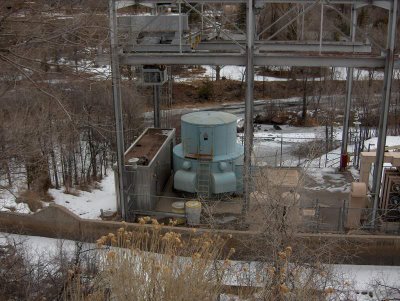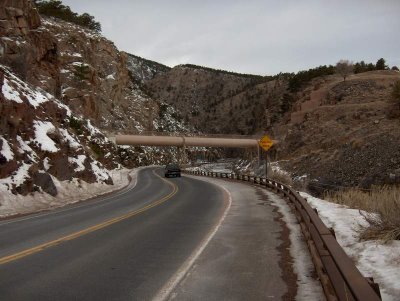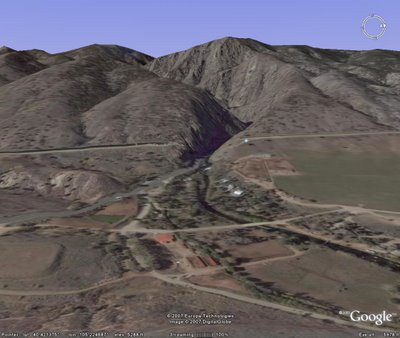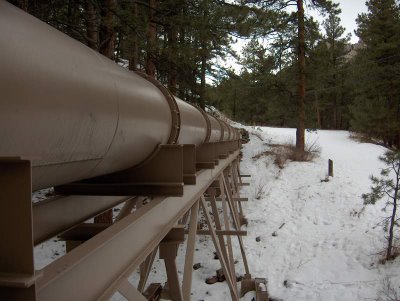After my last posting on Colorado Hydroelectric power, I got a comment related to the fact that there were several hydro plants on the Big Thompson River. I started to do some more research eventually culminating with a visit to canyon yesterday to do some firsthand investigation on the subject.
There are actually two hydro plants situated on the Big Thompson River. One is part of the Colorado Big Thompson (C-BT) project and is located down by the mouth of the canyon near the Dam Store. It’s called the Big Thompson Power Plant and was accounted for in my last posting. It is the smallest of all the C-BT generating plants (4.8 MW) and is only operated during the runoff season from May through September. There is a dam just upriver from it, but the water from that dam is not used to power it. Instead, it is powered by a penstock with 180’of head that comes from the Charles Hansen Feeder canal. The canal runs across Highway 34 via an inverted siphon. That’s the pipe you see when you enter the canyon.

This is the 4.8 MW Big Thompson hydro plant. The large overhead structure is a crane for servicing the generator.
The water in the Charles Hansen Feeder canal can be augmented with the Big Thompson River by a diversion dam located about a mile up the canyon. This small dam feeds water into the Dille tunnel which goes through a mile of solid rock to meet up with the Charles Hansen Feeder canal just south of the inverted siphon. You’ll notice that the pipe is quite a bit lower than the open canal sections that run on either side of it. I’ve included a Google Earth 3D perspective of this phenomenon. I never understood what that pipe did until I flew over it and then it was like a lightbulb going off in my head. I suppose an aqueduct that ran across the canyon at the canal elevation would have cost much more to construct than this inverted siphon. The Charles Hansen canal is used to fill Horsetooth Reservoir with C-BT water.
The Big Thompson power plant’s penstock is formed by a rectangular concrete chute that runs down from the canal on the south side of the highway 34 and is piped under the highway and over to the generating station. In addition, some of the canal water can be simply dumped into the Big Thompson River depending on how they want to move flow along the C-BT project.

This is the inverted siphon that crosses Highway 34. The canal is about 100′ higher than this pipe.

This is a Google Earth 3D view of the mouth of the Big Thompson canyon. You can see that the Charles Hansen canal is much higher in elevation than the pipe that crosses the highway. The power plant water inlet comes from the top of the canal on the left side of the canyon.
I spoke yesterday with a very nice woman from the Bureau of Reclamation by the name of Kara Lamb who posts frequently to a forum sponsored by Mountainbuzz. This forum is monitored by white water kayakers with rapt attention to check flow rates on the Big Thompson River. That way they know when it’s time to ditch work and do some kayaking. Flow rates are changed periodically to send water to where it’s needed and so the volumetric flow can vary unpredictably and thus is important for kayakers to check the forum to see when the water levels are suitable for kayaking. Kara is very knowledgeable about the C-BT project and in the course of one of her postings, she mentioned another power plant on the river owned by the city of Loveland. The power plant she referred to is the Idlewilde Hydro Plant located in Viestenz-Smith Park. This power plant is fed via a penstock from the Idlewilde Reservoir which is located about 2 miles upriver from the plant. The plant is very easy to overlook because it’s not very big and there is not much equipment around it to suggest it’s a power plant. It could easily be mistaken for a maintenance building.
I found in searching around that there was a trail that ran up the canyon on the opposite side from the park called the Foothills Nature Trail that was said to have a few exposed sections of the penstock, which is otherwise buried for the 2 mile distance it runs to the Idlewilde reservoir. I hiked this trail yesterday and took a picture of the metal pipe. It is 3’ in diameter and was originally made of wood back when it was first constructed in 1920’s.

A small exposed section of the Idlewilde Dam-Power Plant penstock. It runs 2 miles, mostly underground from the reservoir to the power plant and can carry 74 cfs of water.
I couldn’t find any information regarding the amount of water flow through the penstock or generating capacity of the Idlewilde plant on the Internet so I went to the park and found some posters that explained a little more about its tumultous history and other interesting facts. The generators inside the building were rated at 900KW which is enough to supply electricity to about 900 homes. Back in the days when the only use for electricity was lighting, this hydro plant could supply a substantial portion of Loveland’s electricity needs.
At 900KW, the Idlewilde hydroelectric plant much smaller than any of the hydro plants that are part of the CB-T project. But since it is not a technically a part of the C-BT project, there is no information about it on the C-BT web pages. The entire facility was completely wiped out in the Big Thompson flood of 1976 and the remnants of the 3 original generators are on display in the park. In the 1980s, the plant was rebuilt and the generators were replaced
with 2 turbines with the same generating capacity. The generating station subsequently returns all the water it receives from the penstock to the river just downstream from the hydro plant.
I also found on the Bureau of Reclamation website that my estimate of 50% for the capacity factor may be too high for several of the C-BT power plants, particularly the Big Thompson Power Plant since it only operates from May-Sept each year. Thus, its capacity factor is only around 20% of its 4.8MW nameplate value. I think that when the river flow is low like it is now in January (~20 cfs), only a portion of the rated power could be generated by the Idlewilde plant. In other words, a 74 cfs diversion flow from the Idlewilde Dam could not be sustained in the winter months and thus it would have to run at reduced capacity. But I was able to hear the generators running, so it appears to be generating at least some electricity year-round.
In talking with Kara, she mentioned that there have been various proposals to add hydro capacity over the years, such as at the outlet of the Olympus Dam in Estes Park, as well as the outlets of Carter Lake and Horsetooth Reservoir. However, these never seem to move forward due to their economics. They just wouldn’t generate enough power to cover their construction and operating expenses.
The more I research the C-BT project, the more impressed I am with the engineering and foresight that went into it. In addition to augmenting the water supply on the Front Range with more capacity that the Big Thompson and Poudre Rivers combined, the designers did an excellent job at extracting all of the available hydro power from the water with minimal environmental impact. It’s hard to fathom that much of the project was implemented more than 60 years ago.
My conclusion is still the same as my original assessment, that is, since now I know that 2 miles of the interior of the Big Thompson canyon essentially has its hydro power harvested to produce less than 1MW of power, the total capacity of the 20 mile stretch of canyon would account for no more than 12 MW of generating capacity which is certainly not enough to justify the environmental impact or economics of pursuing it.


